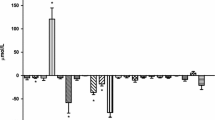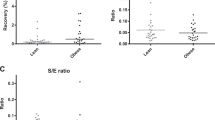Abstract
Gastrointestinal dysfunction in patients with cirrhosis may contribute to complications such as malnutrition and spontaneous bacterial peritonitis. To determine whether cirrhotic patients with ascites have altered intestinal function, we compared intestinal permeability and absorption in patients with liver disease and normal subjects. Intestinal permeability and absorption were investigated in 66 cirrhotic patients (48 with ascites, 18 without ascites) and 74 healthy control subjects. Timed recovery of 3-O-methyl-D-glucose, D-xylose, L-rhamnose, and lactulose in urine following oral administration was measured in order to assess active and passive carrier-mediated, and nonmediated, absorptive capacity, as well as intestinal large-pore/small-pore (lactulose/rhamnose) permeability. Test sugars were measured by quantitative thin-layer chromatography and results are expressed as a percentage of test dose recovered in a 5-h urine collection. Sugar excretion ratios relating to small intestinal permeability (lactulose/rhamnose) and absorption (rhamnose/3-O-methyl-D-glucose) were calculated to avoid the effects of nonmucosal factors such as renal clearance, portal hypertension, and ascites on the recovery of sugar probes in urine. Compared with normal subjects, the mean lactulose/rhamnose permeability ratio in cirrhotic patients with ascites was significantly higher (0.058 vs. 0.037, P < 0.001) but not in cirrhotic patients without ascites (0.041 vs. 0.037). Cirrhotic patients with ascites had significantly lower mean recoveries of 3-O-methyl-D-glucose (23.0 vs. 49.1%; P < 0.001), D-xylose (18.8 vs. 34.5%; P < 0.001), L-rhamnose (4.0 vs. 9.1%; P < 0.001), and lactulose (0.202 vs. 0.337%; P < 0.001) than normal subjects. However, the mean rhamnose/3-O-methyl-D-glucose ratio was the same in cirrhotic patients with ascites as normal subjects (0.189 vs. 0.189), indicating that the reduction in probe recovery was due to nonmucosal factors. Compared with normal subjects, cirrhotic patients with ascites have abnormal intestinal permeability, measured by urinary lactulose/rhamnose excretion, and normal small intestinal absorption, assessed by the urinary rhamnose/3-O-methyl-D-glucose ratio. Low urine recovery of sugar probes found in cirrhotic patients appears to be the result of nonintestinal factors affecting clearance rather than reduced intestinal absorption.
Similar content being viewed by others
References
Quigley EMM: Gastrointestinal dysfunction in liver disease and portal hypertension: gut-liver interactions revisited. Dig Dis Sci 41:557-563, 1996
Navasa M, Rimola A, Rodes J: Bacterial infections in liver disease. Sem Liver Dis 17:323-333, 1997
Runyon BA, Squier S, Borzio M: Translocation of gut bacteria in rats with cirrhosis to mesenteric lymph nodes partially explains the pathogenesis of spontaneous bacterial peritonitis. J Hepatol 21:792-796, 1994
Garcia-Tsao G, Lee FY, Barden GE, Cartun R, West AB: Bacterial translocation to mesenteric lymph nodes is increased in cirrhotic rats with ascites. Gastroenterology 108:1835-1841, 1995
Menzies IS: Transmucosal passage of inert molecules in health and disease. In Intestinal Absorption and Secretion. E Skadhauge, K Heintze (eds). Falk Symposium 36. Lancaster: MTP Press, 1984, 527-543
Bjarnason I, MacPherson A, Hollander D: Intestinal permeability: An overview. Gastroenterology 108:1566-1581, 1995
Menzies IS, Crane R: Quantitative estimation of sugars by thin-layer chromatography and scanning densitometry. Assessing intestinal absorptive capacity and permeability in vivo. In Methods in Disease: Investigating the Gastrointestinal Tract. VR Preedy, RR Watson (eds). London, Greenwich Medical Media Ltd, 1998, 53-63
Enquist JF, Golding MR, Aiello RG, Fierst SM, Solomon NA: The effect of portal hypertension on intestinal absorption. Surg Gynecol Obstet 120:87-91, 1965
Marin GA, Clark ML, Senior JR: Distribution of D-xylose in sequestered fluid resulting in false-positive tests for malabsorption. Ann Intern Med 69:1155-1162, 1968
Losowsky MS, Walker BE: Liver disease and malabsorption. Gastroenterology 56:589-600, 1969
Chesta J, DeFilippi C, DeFilippi C: Abnormalities in proximal small bowel motility in patients with cirrhosis. Hepatology 17:828-832, 1993
Casafont Morencos F, de las Heras Castano G, Martin Ramos L, Lopez Arias MJ, Ledesma F, Pons Romero F: Small bowel overgrowth in patients with alcoholic cirrhosis. Dig Dis Sci 41:552-556, 1996
Chang CS, Chen GH, Lien HC, Yeh HZ: Small intestine dysmotility and bacterial overgrowth in cirrhotic patients with spontaneous bacterial peritonitis. Hepatology 28:1187-1190, 1998
Bauer TM, Steinbruckner B, Brinkmann FE, et al.: Small intestinal bacterial overgrowth in patients with cirrhosis: prevalence and relation with spontaneous bacterial peritonitis. Am J Gastroenterol96:2962-2967, 2001
Balan KK, Grime S, Sutton R, Critchley M, Jenkins SA: Abnormalities of gastric emptying in portal hypertension. Am J Gastroenterol 91:530-534, 1996
Cook GC, Menzies IS: Intestinal absorption and unmediated permeation of sugars in post-infective tropical malabsorption (tropical sprue). Digestion 33:109-116, 1986
Griffiths CEM, Menzies IS, Borrison I, et al.: Intestinal permeability in dermatitis herpetiformis. J Invest Dermatol91:147-149, 1988
Budillon G, Parrilli G, Pacella M, Cuomo R, Menzies IS: Investigation of intestine and liver function in cirrhosis using combined sugar oral loads. J Hepatol 1:513-524, 1985
Romiti A, Merli M, Martorano M, Parrilli G, Martino F, Riggio O, Truscelli A, Capocaccia L, Budillon G: Malabsorption and nutritional abnormalities in patients with liver cirrhosis. Ital J Gastroenterol 22:118-123, 1990
Such J, Runyon B: Spontaneous bacterial peritonitis. Clin Infect Dis 27:669-676, 1998
Menzies IS, Zuckerman MJ, Nukajam WS, Somasundaram SG, Murphy B, Jenkins AP, Crane RS, Gregory GG: Geography of intestinal permeability and absorption. Gut 44:483-489, 1999
Menzies IS: Quantitative estimation of sugars in blood and urine by paper chromatography using direct densitometry. J Chromatogr 81:109-127, 1973
Menzies IS, Mount JN, Wheeler MJ: Quantitative estimation of clinically important monosaccharides in plasma by rapid thin layer chromatography. Ann Clin Biochem 15:65-76, 1978
Campillo B, Pernet P, Bories PN, Richardet JP, Devanlay M, Aussel C: Intestinal permeability in liver cirrhosis: relationship with severe septic complications. Eur J Gastroenterol Hepatol 11:755-759, 1999
Fujii T, Seki T, Marvoka M, et al.: Lactulose-L-rhamnose intestinal permeability test in patients with liver cirrhosis. Hepatol Research19:158-169, 2001
Keshavarzian A, Holmes EW, Patel M, Iber F, Fields JZ, Pethkar S: Leaky gut in alcoholic cirrhosis: a possible mechanism for alcohol-induced liver damage. Am J Gastroenterol 94:200-207, 1999
Resnick RH, Royal H, Marshall W, Barron R, Werth T: Intestinal permeability in gastrointestinal disorders: Use of oral 99mTc DTPA. Dig Dis Sci 35:205-211, 1990
Ersoz G, Aydin A, Erdem S, Yuksel D, Akarea U, Kumanlioglu K: Intestinal permeability in liver cirrhosis. Eur J Gastroenterol Hepatol 11:409-412, 1999
Huglo D, De Button S, Canva-Delcamber V, et al.: Simultaneous determination of pulmonary and intestinal permeability in patients with alcoholic cirrhosis. Eur J Nucl Med28:1505-1511, 2001
Norman DA, Atkins JM, Seelig LL, Gomez-Sanchez C, Krejs GJ: Water and electrolyte movement and mucosal morphology in the jejunum of patients with portal hypertension. Gastroenterology 79:707-715, 1980
Misra V, Misra SP, Dwivedi M, Gupta SC: Histomorphometric study of portal hypertensive enteropathy. Am J Clin Pathol 108:652-657, 1997
Llovet JM, Bartoli R, Planas R, et al.: Bacterial translocation in cirrhotic rats. Its role in the development of spontaneous bacterial peritonitis. Gut35:1648-1652, 1994
Runyon BA, Borzio M, Young S, Squier SU, Guarner C, Runyon MA: Effect of selective bowel decontamination with norfloxacin on spontaneous bacterial peritonitis, translocation, and survival in an animal model of cirrhosis. Hepatology 21:1719-1724, 1995
Ho H, Zuckerman MJ, Ho TK, Guerra LG, Verghese A, Casner PR: Prevalence of associated infections in community-acquired spontaneous bacterial peritonitis. Am J Gastroenterol 91:735-742, 1996
Fordtran JS, Clodi PH, Soergel KH, et al.: Sugar absorption tests, with special reference to 3-0-methyl-D-glucose and D-xylose. Ann Intern Med57:883-891, 1962
Craig RM, Ehrenpreis ED: D-xylose testing. J Clin Gastroenterol 29:143-150, 1999
Author information
Authors and Affiliations
Rights and permissions
About this article
Cite this article
Zuckerman, M.J., Menzies, I.S., Ho, H. et al. Assessment of Intestinal Permeability and Absorption in Cirrhotic Patients with Ascites Using Combined Sugar Probes. Dig Dis Sci 49, 621–626 (2004). https://doi.org/10.1023/B:DDAS.0000026307.56909.21
Issue Date:
DOI: https://doi.org/10.1023/B:DDAS.0000026307.56909.21




